Authors: White55 & Luke, Marsbit
When global central banks are deeply mired in stagflation, Wall Street's capital behemoths pushed Bitcoin to a historic throne of $120,000 and Ethereum to $3,800 with an epic short squeeze - this is not only a digital breakthrough but also a silent declaration of the collapse of the old financial order.
Institutions carve new rules with real money: BlackRock's single ETF holdings surpass Swiss gold reserves, 125 listed companies write 847,000 Bitcoins into their balance sheets, 4.3% of the circulating chips are permanently frozen; the 250 billion market value of stablecoins builds a new artery for cross-border payments, and under the iceberg of 24.4 billion real assets anchored on RWA chains, a trillion-dollar territory of traditional finance is being swallowed by Washington legislation ((GENIUS Act)) and Wall Street operations (ETFs absorbing 300 million US dollars per day) - and all of this is just the prelude to the restructuring of the global asset pattern by encrypted capital in the first half of 2025 - this report will dissect the ice and fire battlefield of this capital restructuring and review the life-and-death game in the encrypted market in the first half of 2025.
Washington Thawing: How Regulatory Clarity Became the Core Engine of the Bull Market
In the second quarter of 2025, the cryptocurrency market walked out of a remarkable independent market in a fog of macroeconomic conditions. When global investors are still worried about tariff disputes, Fed policies, and slowing economic growth, a regulatory warm current originating from Washington is quietly reshaping the foundation of the entire industry. This is not just a quarterly rebound, but a structural turning point. The dawn of regulation has paved the way for the large-scale entry of institutions, and the entry of institutions has opened an unprecedented wave of 'Bitcoin corporatization'.
For a long time, the sword of Damocles hanging over the crypto industry – regulatory uncertainty – began to melt away in the second quarter of 2025. The core driving force behind this round of market sentiment and direction is not derived from improved macroeconomic conditions, but rather from the fundamental 'thawing' and 'de-risking' of the US regulatory environment. This series of changes created the crucial preconditions for the large-scale adoption by institutions and enterprises that will be detailed in subsequent chapters.
The first is the laying of the foundation for stablecoins. As a bridge connecting traditional finance and the crypto world, the implementation of a stablecoin regulatory framework is a milestone. On June 17, 2025, the US Senate passed the (Guiding and Establishing America's Stablecoin National Innovation Act) (GENIUS Act) with overwhelming bipartisan support. This is the first crypto-specific bill in history to be passed by either house of Congress, and the White House has also expressed support for it. The bill establishes a dual regulatory system at the federal and state levels, mandating that issuers use high-quality liquid assets to support 1:1 reserve funds and including issuers under the jurisdiction of the (Bank Secrecy Act). This series of measures provides digital dollars with unprecedented legitimacy and stability, which is the foundation of trust necessary for large-scale participation by institutional players. The passage of the bill directly benefits compliant issuers such as Circle (USDC issuer) seeking to be listed in the US, clearing the biggest obstacle for them, and indirectly puts more compliance pressure on offshore issuers such as Tether (USDT issuer).
Second, Congress began to address the industry's biggest pain point: the ambiguous jurisdictional dispute between the SEC and the CFTC. Following the (Financial Innovation and Technology Act of the 21st Century) (FIT21) in 2024, the (CLARITY Act) was also approved by key committees in the House of Representatives in June 2025. The core objective of these two bills is to provide a clear legal framework for the classification and regulation of digital assets, and to clearly give the CFTC jurisdiction over the spot market of 'digital commodities' (such as Bitcoin). This marks the fact that US crypto regulation is shifting from the confrontational model of 'enforcement as legislation' to building a clear and predictable legal path. Behind this shift is the result of years of continuous political lobbying by the crypto industry, costing hundreds of millions of dollars, and leading institutions such as Coinbase and a16z played a key role in it, successfully transforming crypto issues from partisan disputes to national issues related to US technological competitiveness and financial innovation.
Finally, there is a shift at the administrative level. In April 2025, the president signed a bill to formally abolish the IRS's controversial 'DeFi broker rule.' At the same time, with the departure of former Chairman Gary Gensler in January 2025, the SEC's regulatory attitude also underwent a significant change, reducing enforcement actions and establishing a more industry-friendly working group under the leadership of Commissioner Hester Peirce, who is known as the 'crypto mother.' These three major regulatory developments - the legalization of stablecoins, the clarification of market structure, and the friendly attitude of the administration - together constitute a solid 'regulatory tripod,' forming a mutually reinforcing positive cycle of confidence. As BlackRock CEO Larry Fink has repeatedly emphasized, ETFs are just 'stepping stones to tokenization.' A regulated, liquid, and credible digital dollar system is the underlying settlement network necessary for the future trillion-dollar real-world asset (RWA) tokenization economy.
Navigating the Macroeconomic Mist: Tariffs, the Fed, and the Evolution of Bitcoin's Narrative
The macroeconomic environment in the second quarter can be described as overcast. However, it is in this mist that Bitcoin has demonstrated increasing resilience, and its trend is increasingly driven by its own powerful, crypto-native catalysts, rather than being passively subject to the external environment.
This quarter, the main source of macroeconomic uncertainty was the so-called 'tariff turmoil.' The new government's intermittent trade policies stirred up global financial markets, once leading to synchronous declines in stocks, bonds, and even Bitcoin. Data shows that Bitcoin's correlation with the US stock market remained high at the end of the quarter. However, a key narrative tension is that, despite facing such significant macroeconomic headwinds, Bitcoin still achieved a strong rebound in the second quarter and hit a historic high of over $118,000 yesterday. This indicates that there is a force stronger than macroeconomic sentiment driving its price.
The Fed's policy stance did not bring a clear tailwind to risk assets. At the May and June FOMC meetings, the Fed chose to keep interest rates in the 4.25%-4.50% range. Economic data paints a contradictory picture: on the one hand, inflation remains sticky; on the other hand, the US economy contracted in the first quarter. This potential 'stagflation' concern usually inhibits investors' risk appetite. At the same time, the US dollar index (DXY) weakened significantly, falling nearly 11% in the first half of 2025, the worst semi-annual performance since 1973. The weakness of the dollar, coupled with the US government's record fiscal deficit, makes 'currency devaluation' no longer a theoretical discussion but a reality for all investors.
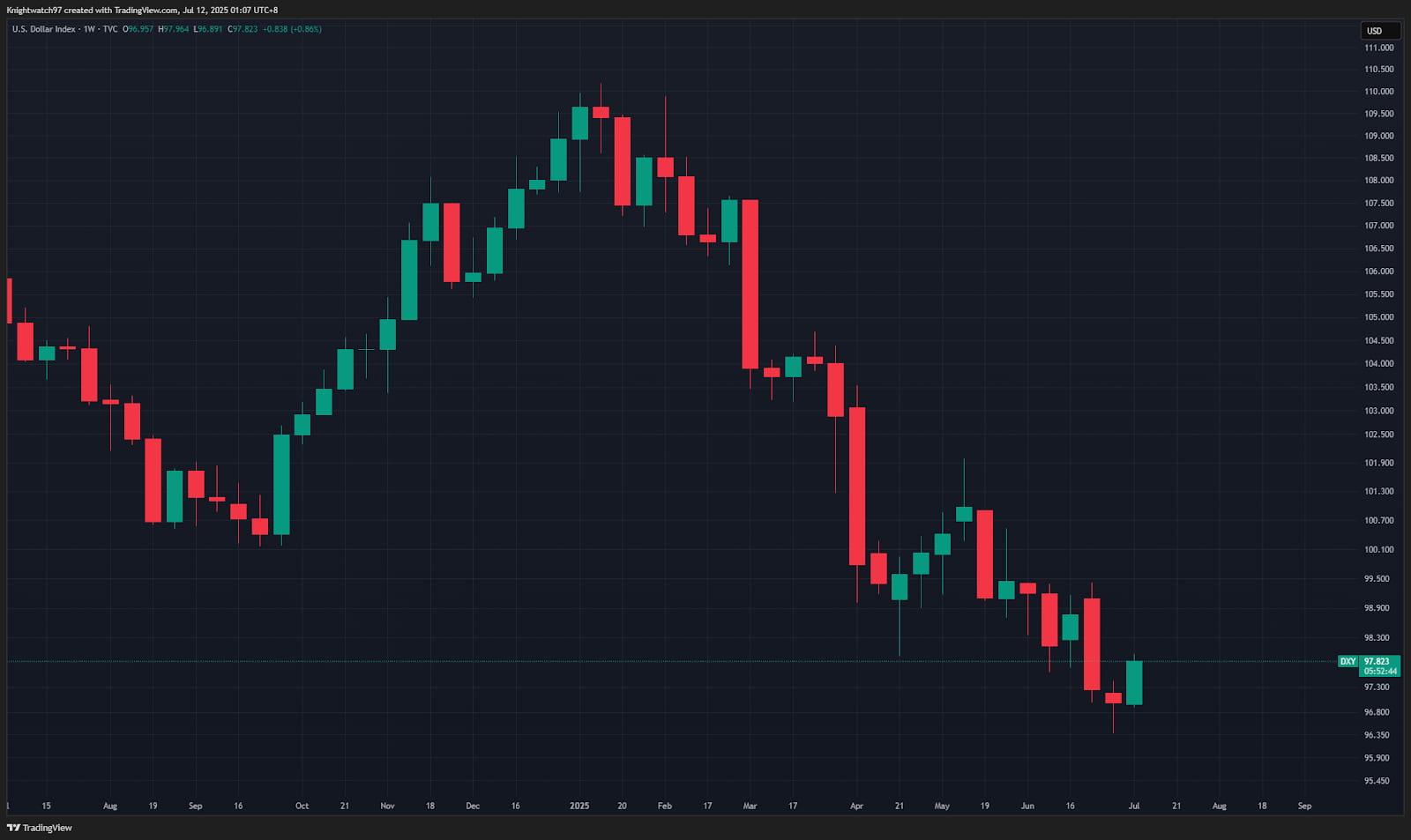
This phenomenon reveals a deeper trend: the second quarter of 2025 may mark the beginning of a 'great divergence.' In this divergence, the strength of the internal structural catalysts driving Bitcoin (such as the aforementioned regulatory clarity and institutional adoption) is beginning to overwhelm external macroeconomic headwinds for the first time. The market's weighted pricing of crypto-native drivers has exceeded its reaction to short-term macroeconomic noise. This in itself is an important sign of market maturity. The weakness of the macroeconomy provides a real-world problem background for the narrative of 'Bitcoin as a solution,' greatly accelerating its acceptance as a legitimate macroeconomic hedging asset. It was at this time that institutional leaders such as Larry Fink began to frequently define Bitcoin as an 'international asset' that can hedge against geopolitical risks and sovereign currency devaluation in the mainstream financial media, and the weight of this endorsement from the head of the world's largest asset management company is far greater than that of evangelists within the crypto circle.
Institutional sluice gates open: from ETF highways to corporate treasuries
If regulatory thawing is 'timing,' macroeconomic turmoil is 'location,' then the rush of institutions and enterprises is the decisive 'human factor.' In the second quarter, we clearly saw institutional capital pouring into Bitcoin through two main paths: one is the ETF channel, which has become a climate, and the other is the explosive growth of the corporate treasury wave.
The US spot Bitcoin ETF continued its historic success in the second quarter. Data shows that these ETFs attracted more than $3 billion in net inflows in just one week in April. As of early July, the total assets under management (AUM) of all Bitcoin ETFs had reached $137.46 billion. Among them, BlackRock's IBIT was called 'the fastest-growing product in the history of ETFs' by its CEO Larry Fink himself and once attracted nearly $1 billion in inflows in a single day. Fink admitted that he was 'surprised' by the scale of the demand and thought it far exceeded expectations. The success of ETFs lies not only in their ability to attract money but also in the fact that they have completely changed the investor structure of Bitcoin. The market, which was previously dominated by retail investors and crypto funds, is now welcoming the indirect participation of sovereign wealth funds, pension funds, and large corporate consortia.
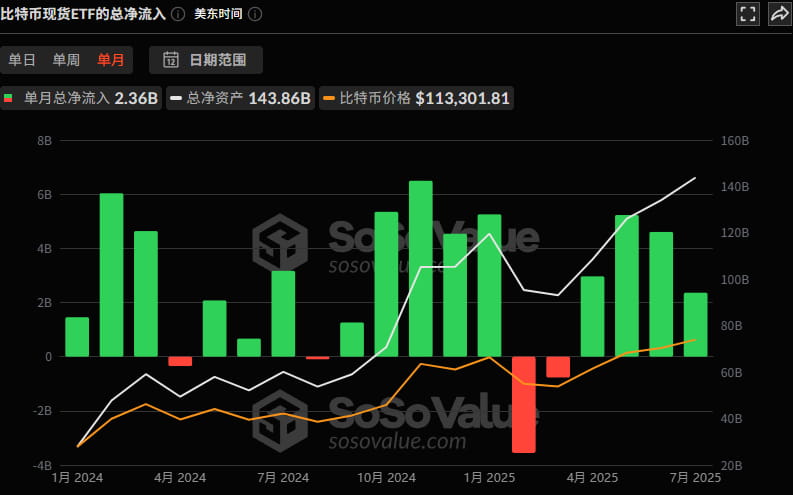
A more profound structural shift than ETFs is the rise of the 'Corporatization of Bitcoin' wave. More and more listed companies are no longer treating Bitcoin merely as a speculative product but as a core reserve asset. Data shows that listed companies around the world increased their holdings by approximately 131,000 Bitcoins in the second quarter of 2025 alone, increasing their total holdings by 18%. As of July 4, corporate treasuries held a total of 944,109.2 Bitcoins. This movement is no longer a solo performance by MicroStrategy but has evolved into a global, cross-industry corporate finance revolution. The entry of Japanese listed company Metaplanet is particularly representative, as the company clearly stated that it purchased Bitcoin to hedge against the long-term devaluation risk of the Japanese yen, which opened up a new paradigm of 'Bitcoin as a national currency hedging tool'.
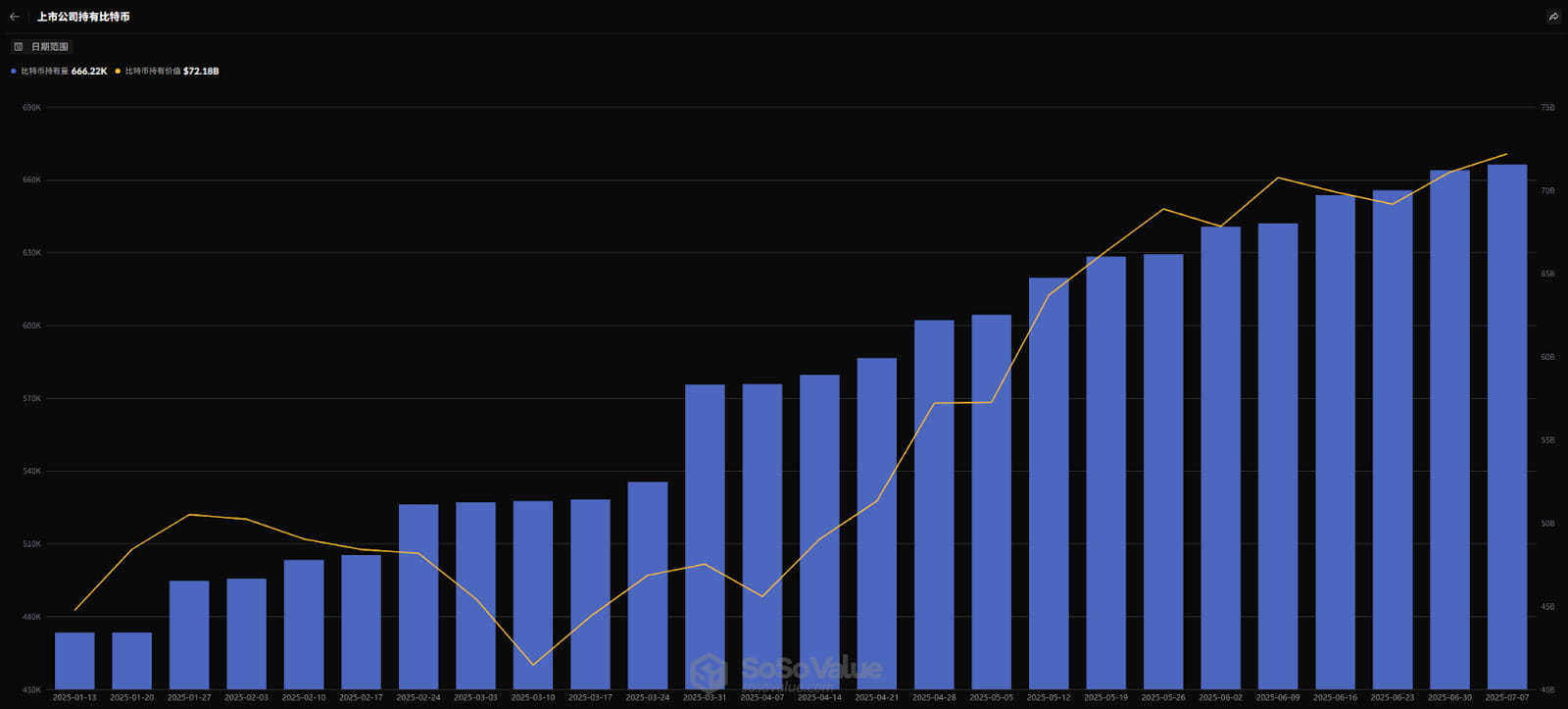
Behind this trend is a deeper adoption logic. ETFs are a 'touch' tool, while using Bitcoin as the company's main treasury reserve is a core 'integration' strategy. It means that the company's management believes in Bitcoin as a long-term store of value, even thinking it is superior to cash. The new regulations implemented by the US Financial Accounting Standards Board (FASB) at the end of 2024 allow companies to measure their held crypto assets at fair value, which greatly improves the presentation of financial statements and clears the technical obstacles for more CFOs to include Bitcoin in the balance sheet. A brand-new 'Bitcoin Vault Company' sector is forming, which provides traditional equity investors with a way to obtain leveraged exposure to Bitcoin through the stock market, thereby embedding Bitcoin more deeply into the traditional financial system.
Echoes on the Blockchain: On-Chain Data Validates Institutional Beliefs
If regulatory and institutional dynamics are the market's 'narrative,' then on-chain data is the 'fact' that validates these narratives. The on-chain metrics for the second quarter of 2025 clearly paint a picture of institution-led, long-term belief-based accumulation.
First, in market volatility, capital exhibits a classic 'flight to quality' characteristic. Bitcoin's dominance index soared to 63%, the highest since early 2021. At the same time, the total market value of cryptocurrencies excluding Bitcoin fell sharply. This dramatic divergence indicates that in the face of uncertainty, capital is rapidly concentrating on the most liquid, most institutionally recognized asset - Bitcoin. This is completely in line with the behavior patterns of institutional investors first ensuring core asset allocation during periods of risk.
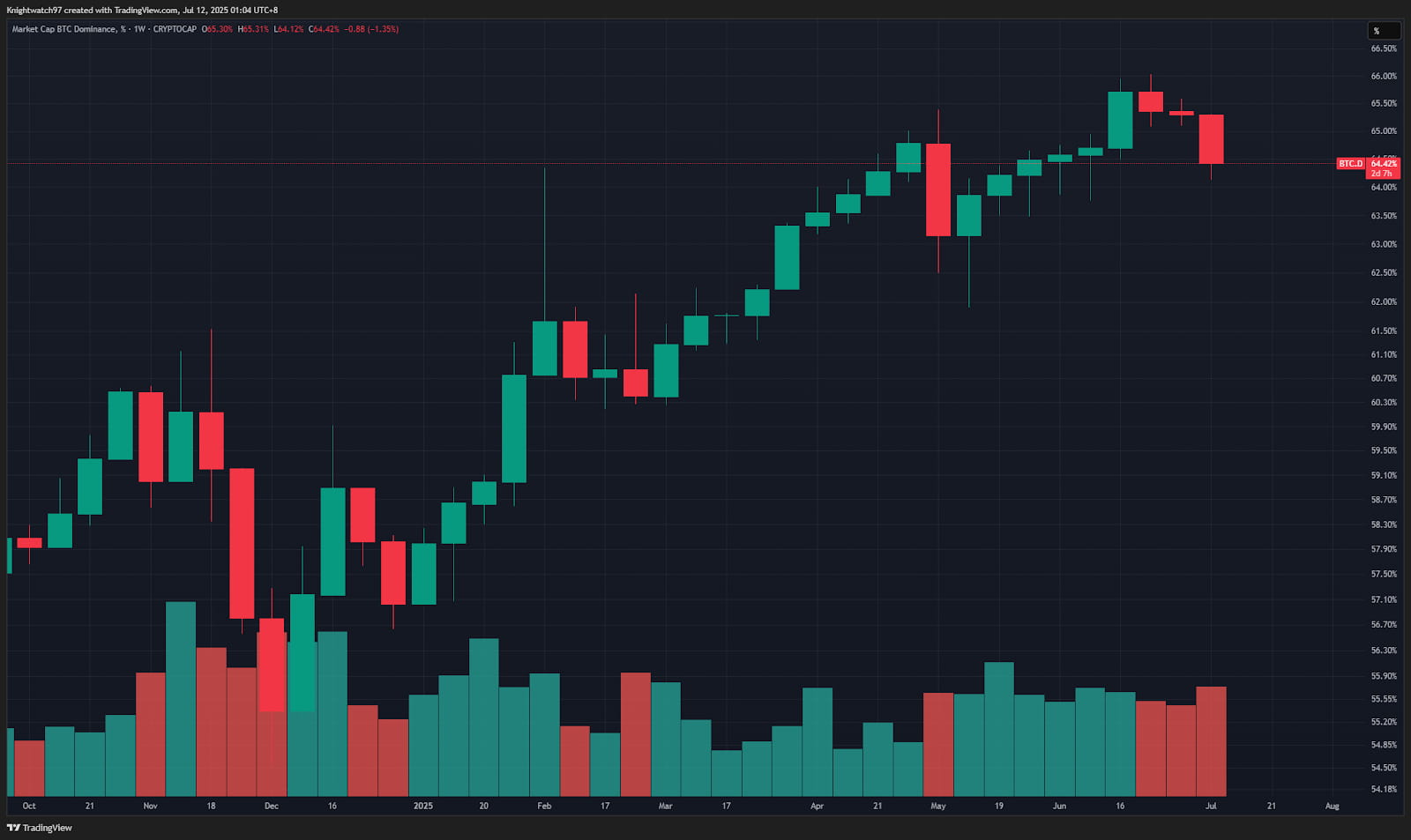
Second, the key 'Long-Term Holder, LTH' indicator shows a firm accumulation behavior. Despite the sharp price fluctuations, the supply of Bitcoin held by LTHs increased by a net 600,000 in the second quarter. A joint report by Coinbase and Glassnode confirmed that 'long-term holders are accumulating again.' These Bitcoins are transferred to addresses with statistically very low spending probabilities, which is consistent with the behavior patterns of institutions and enterprises establishing long-term strategic positions. More importantly, we see a steady rise in the Realized Cap, which indicates that new capital is entering at higher cost price points, consolidating the market's price base.
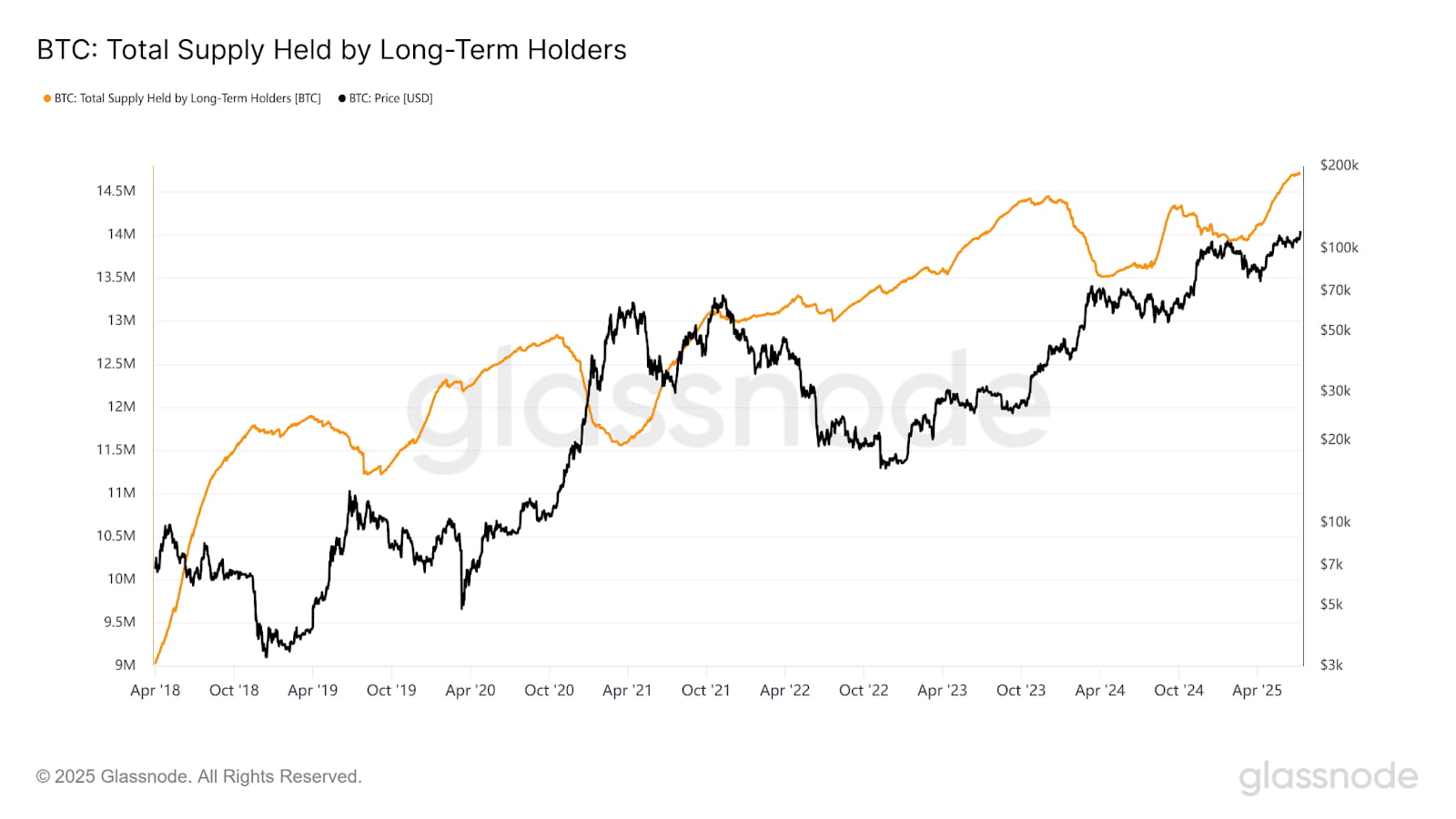
Furthermore, the Bitcoin balance on exchanges continues to decline, which is a strong bullish signal. When investors intend to hold for the long term, they tend to withdraw assets from exchanges to self-custodial wallets or institutional-grade custody solutions. The reduction in the supply of liquidity available for immediate sale within exchanges directly exacerbates the supply-demand imbalance in the face of huge demand from ETFs and corporate treasuries. According to statistics, the number of Bitcoins absorbed by ETFs every day once exceeded 10 times the daily output of miners, and this structural supply-demand imbalance is the most fundamental driving force for price increases.
Finally, the number of 'whale' addresses holding more than $1 million worth of Bitcoin increased from approximately 124,000 in mid-March to more than 160,000 in June. This significant increase in large-value addresses is strong circumstantial evidence of the entry of institutions and high-net-worth individuals. These on-chain data together constitute the 'behavioral fingerprint' of institutional capital, which is in stark contrast to the characteristics commonly seen in previous retail-dominated cycles, such as surges in exchange inflows and increases in short-term holder supply, and clearly reveals the fundamental changes in the behavior patterns of market participants. A new Bitcoin cycle dominated by institutions and centered on the narrative of value storage is leaving its solid footprints on the blockchain.
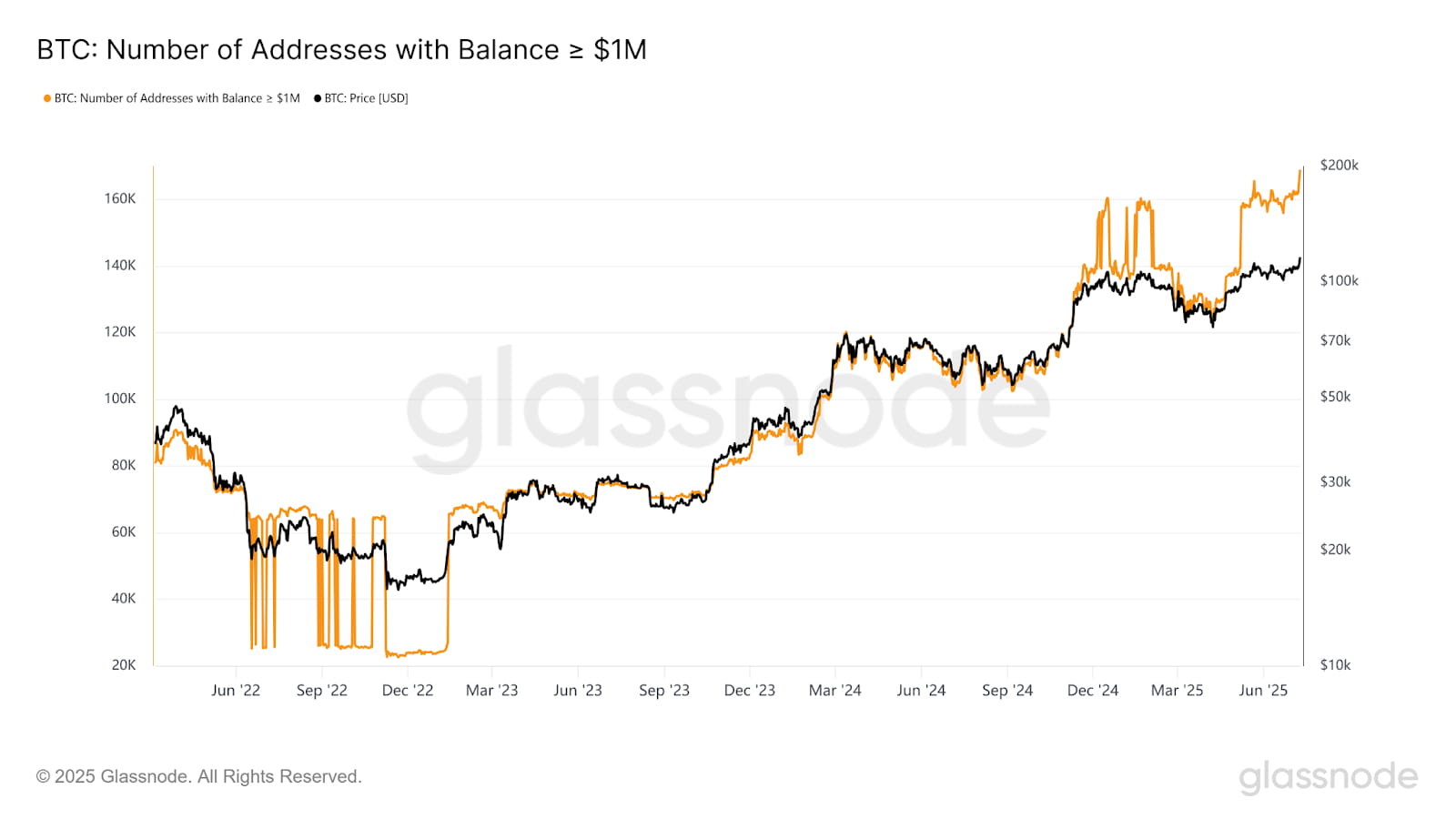
SEC's new policy, from 'innovation exemption' to 'on-chain finance,' DeFi Summer may reappear
Overall progress and regulatory turning point of the track
In the first half of 2025, the DeFi field ushered in a key regulatory breakthrough. On June 9, the US SEC proposed an 'innovation exemption' framework, clearly supporting the intermediary-free nature of blockchain technology and emphasizing that developers should not bear securities law responsibility for publishing code.
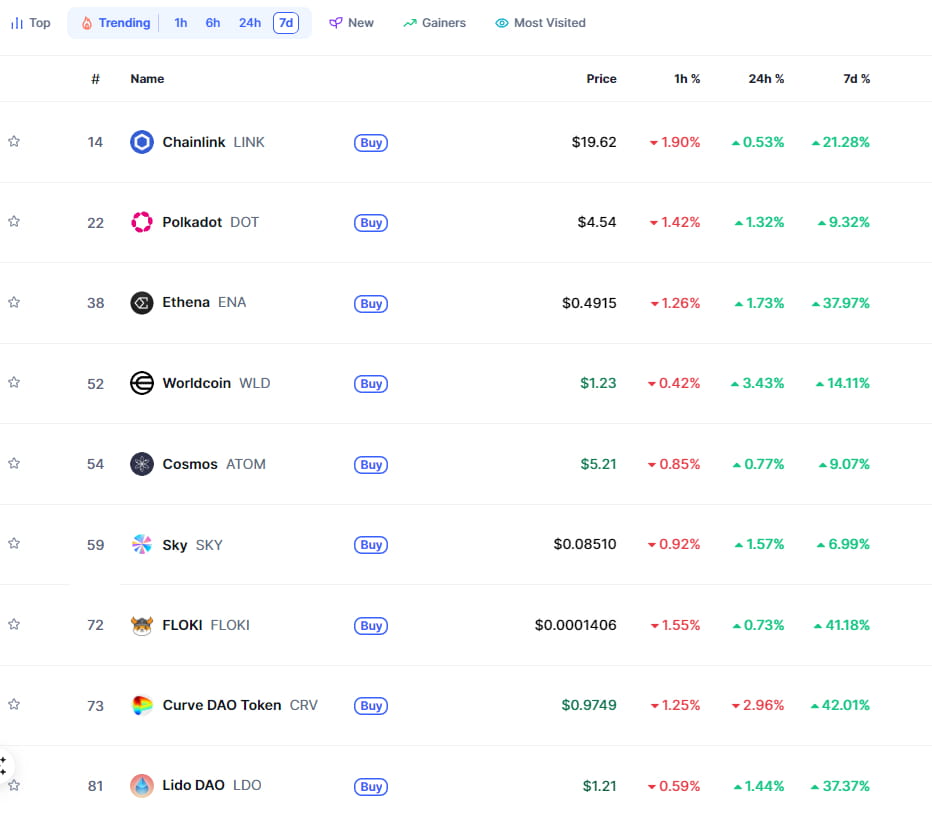
This policy shift greatly alleviated regulatory uncertainty, and then DeFi tokens generally rose 20%-40%, which was regarded as the starting point for the industry's institutional restructuring.
The total TVL is stable and rising

Overall TVL: Affected by Trump's tariff policy at the beginning of the year, DeFi TVL fell from $129 billion at the beginning of the year to $83.6 billion in April, but rebounded with the market recovery from April.
AAVE lending volume hits new highs, scale and synergy drive growth
AAVE has built a strong network effect barrier in the DeFi field. Relying on five years of market cultivation, massive users, and industry-leading liquidity, projects developed based on AAVE naturally enjoy scale advantages that are difficult to replicate.
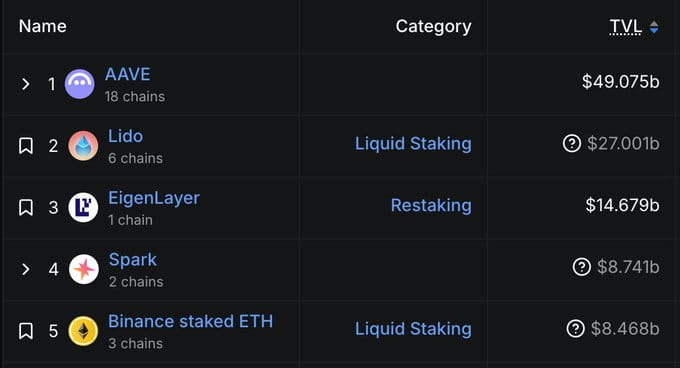
Partners can quickly access existing ecological resources - a strong infrastructure, an active user base, and deep liquidity pools, saving the long basic construction period, which is the embodiment of the 'AAVE effect'.
As the protocol with the largest TVL in DeFi history, AAVE dominates with 21% of the industry's TVL and an overwhelming 51% share of the lending market. Its $49 billion net deposit scale constitutes the cornerstone of system stability. The core advantage lies in its unique capital hub role, which can effectively catalyze ecological synergy and achieve geometric growth of liquidity:
Significant Synergy Illustrated:
After Ethena's sUSDe was connected to AAVE, deposits surged 55 times in just two months, from $2 million to $1.1 billion.
Weeks after Pendle assets were supported by AAVE, users deposited PT tokens worth $1 billion, and the value has now doubled to $2 billion, making AAVE the primary supply market for Pendle tokens.
After KelpDAO's rsETH was integrated into the AAVE protocol, TVL increased nearly 4 times in four months, soaring from 65,000 ETH to 255,000 ETH.
In addition, AAVE supports nearly half of the active stablecoin market and has become the primary hub for circulating Bitcoin in the DeFi field. It is particularly noteworthy that it has achieved nearly $1 billion in TVL on four independent blockchain networks, demonstrating a rare depth of layout and breadth.
The first half of 2025 is a turning point for DeFi, moving from a regulatory winter to institutionalization. Aave has consolidated its 'lending hegemony' with liquidity depth, demand creation capabilities, and multi-chain expansion, but its token has not fully reflected its value; and the capital repatriation and innovation unbundling triggered by the SEC's new policy are pushing DeFi into the 'endgame battle' of integration with traditional finance.
2025 Cryptocurrency Public Chain Panorama in the First Half of the Year: Ethereum, Solana, BNB Chain, and Hyperliquid's Breakthroughs and Evolutions
First, Ethereum: ETF funds support the bottom, and technology upgrades reconstruct the ecological moat
Token Price: Deep V Rebound Confirms Institutional Confidence
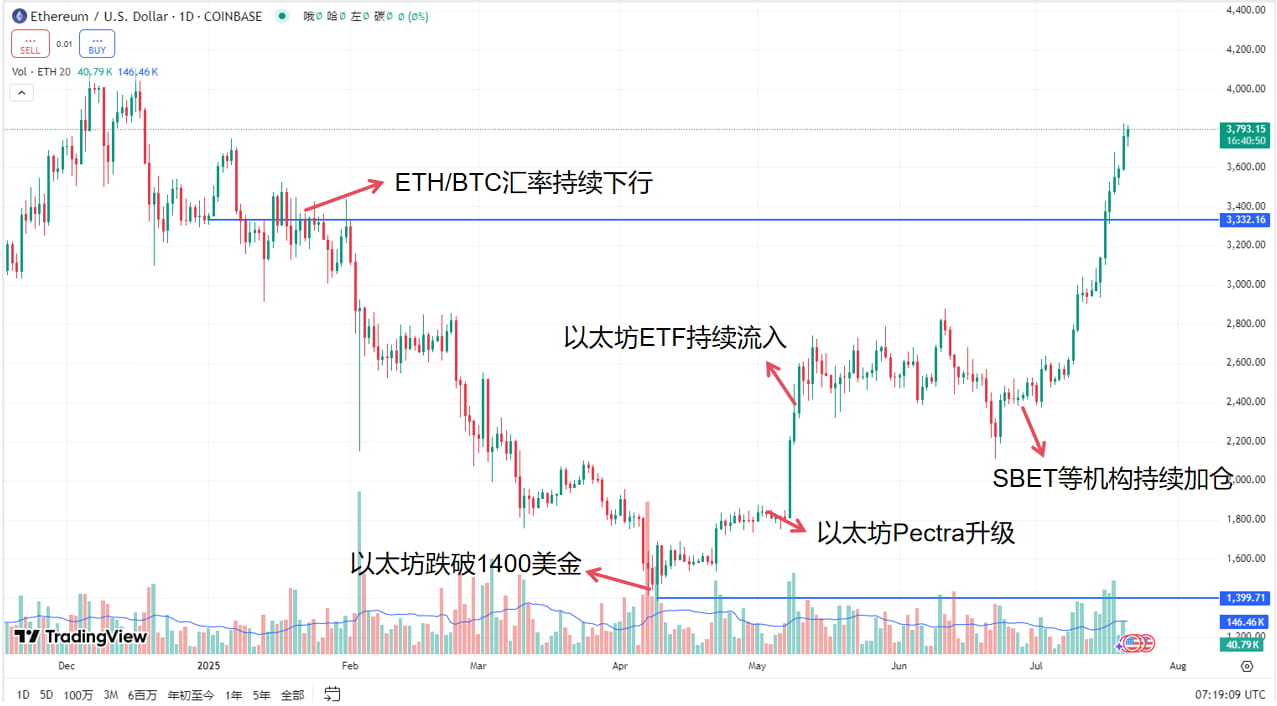
In early 2025, Ethereum started at a high of $3,700, but due to sticky macro inflation, the Trump administration's tariff policies, and market liquidity contraction, it once plunged to a low of $1,385 within the year in April. The turning point began with the implementation of the Pectra upgrade in May: This upgrade increased the single-node staking limit from 32 ETH to 2048 ETH and introduced account abstraction (EIP-7702 standard), significantly improving network efficiency and user experience, driving ETH to surge 40% in 72 hours.
Since then, with the continued inflow of US Ethereum ETFs, US-listed companies such as SBET and BMNR strategically reserve ETH, and related bills such as the (GENIUS Stablecoin Act) and the (Digital Asset Market Clarity Act) have been passed, institutional funds continue to pour into Ethereum.
As of July 20, ETH broke through $3,800, hitting a new high for the year, with a year-to-date increase of over 20%. Spot ETFs have seen net inflows for two consecutive months, with a cumulative scale of $13.7 billion. BlackRock's IBIT alone accounts for over 40% of the holdings.
Ecological Evolution: From DeFi Hegemony to Diversified Expansion of RWA and L2
Despite facing competition from public chains such as Solana, Ethereum's dominance in the DeFi field has not been shaken - the total locked value (TVL) reached $103.3 billion, of which RWA (real-world assets) on-chain driven by private credit has become a new growth pole, with a scale exceeding $24.4 billion.
Layer2 solutions have become the core carrier of expansion: Arbitrum, Optimism, etc., process 90% of the network's transactions, promoting the implementation of institutional-grade applications such as JPMorgan Chase's deposit token JPMD on the Base chain.
In addition, the Ethereum ecosystem is extending to AI and compliance: Consensys is cooperating with Microsoft to develop an enterprise-level smart contract platform, and the implementation of MiCA regulations in the EU further strengthens the penetration of compliant stablecoins such as USDC, injecting long-term stability into the ecosystem.
Two, Solana: Ecological explosion under the speed revolution and MEME craze
Token Price: Geopolitical Catalysis Fluctuations, Technical Advantages Support Rebound
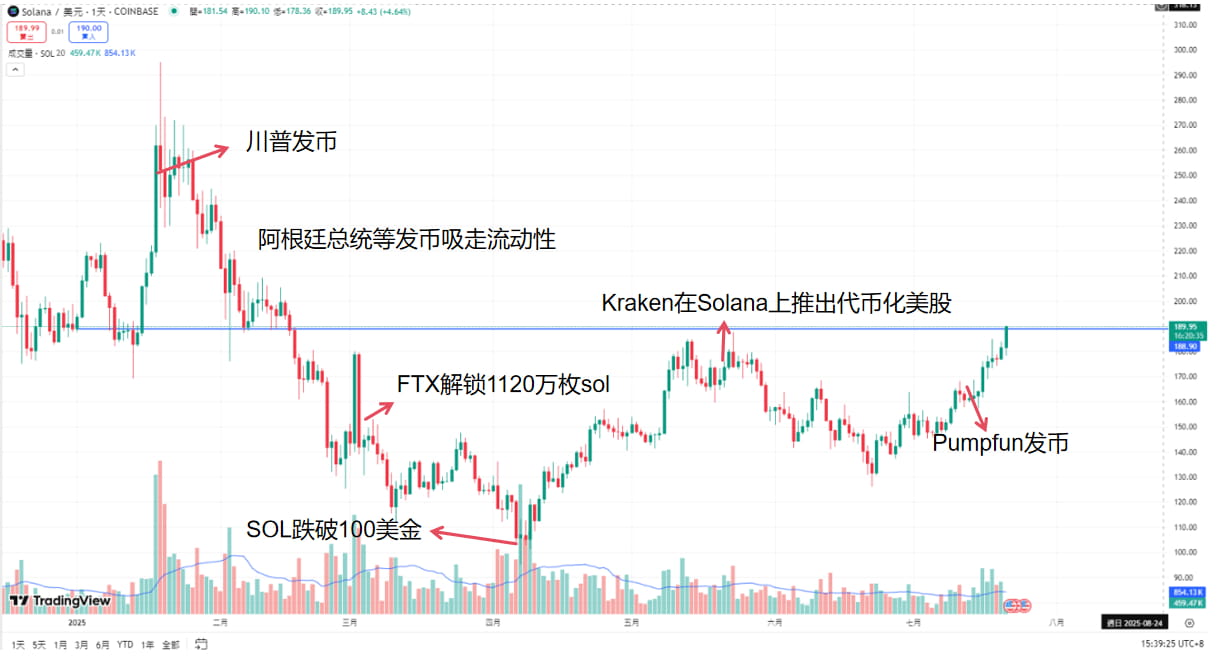
The Trump issuing 'TRUMP' token event at the beginning of the year detonated the Solana ecosystem, and also absorbed a large amount of liquidity. SOL soared to a historical high of $295 in January and then fell rapidly. In April, affected by macro headwinds, the price fell below $100.
After that, with the underlying performance advantages and strategic cooperation deepening, SOL started a shock rebound: In May, PayPal integrated the Solana payment system, and Visa expanded its stablecoin settlement pilot, pushing the price back to $190 (as of July 20), a rise of nearly 90% from the low.
The market's valuation of it is significantly different - 21Shares gives a fair range of $520-1800 based on the discounted cash flow model, implying extreme expectations for the growth of on-chain transaction volume.
Ecological evolution: from 'Nasdaq-level' trading platform to AI agent test site
Solana is reconstructing the public chain competition paradigm with speed and cost: a block generation time of 0.44 seconds, a transaction fee of $0.00025, and a performance of 65,000 TPS make it crush competitors in retail payment and high-frequency trading scenarios.
On-chain transaction volume reached $364.3 billion from January to February 2025, surpassing Coinbase and Ethereum, and approaching 50% of Nasdaq's volume during the same period. The ecosystem explosion is driven by three engines:
MEME coin infrastructure: The Pump.fun platform has accumulated more than $575 million in transaction fee revenue, becoming the core entry point for retail speculation;
Enterprise-level payment network: The access of PayPal, Stripe, and Shopify makes Solana the 'next-generation Visa';
AI agent explosion: The number of DePIN and AI intelligent agent projects has surged, and the market value of stablecoins on the chain has exceeded $10.9 billion, an increase of 600% in half a year.
The number of developers increased by 83% year-on-year, surpassing Ethereum for the first time. The Firedancer upgrade plan may push TPS to the million level, further consolidating the technical barrier.
Three, BNB Chain: Value resilience under ecological diversification and CZ influence
Token Price: Value Reassessment Under Regulatory Pressure
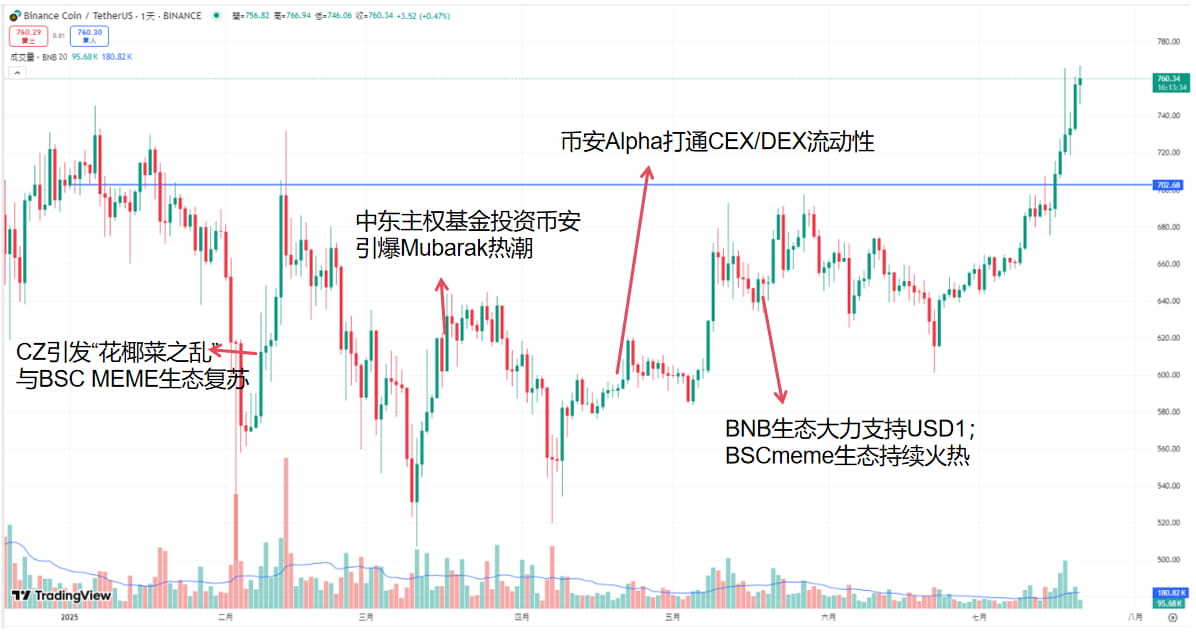
BNB fell back from a high of $740 at the beginning of the year, and fell to a low of $500 in April.
After that, the ecosystem's self-healing ability appeared: CZ continued to output industry compliance initiatives on Twitter, Build BSC ecology, and promote market confidence recovery; the Memecoin craze and the influx of RWA projects into BSC stimulated BNB to rebound to $766 in July, approaching the historical peak.
Four, Hyperliquid: The counterattack logic of the decentralized derivatives dark horse
Token Price: Value Discovery Under Whale Escort and Deflation Model
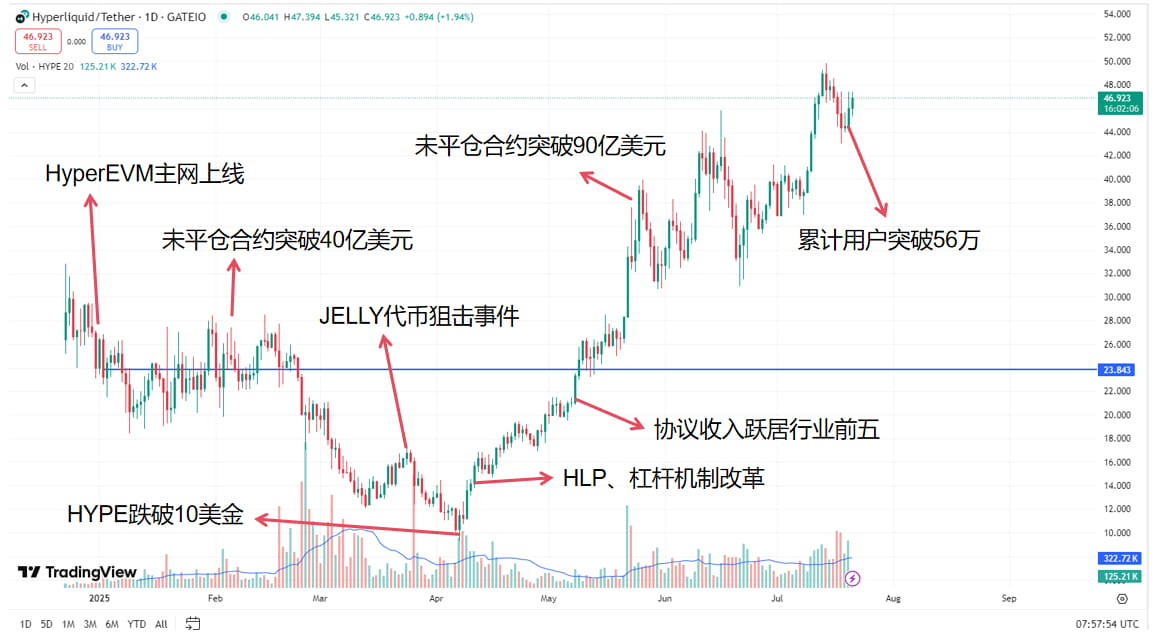
The HYPE token started a downward channel from $28 at the beginning of the year, and fell below $10 in April due to the HLP fund attack caused by the 'Jelly Incident'. Then, with the fee repurchase mechanism and transaction volume explosion, it started a counterattack: the platform's daily transaction volume exceeded $15 billion, 50% of the daily fee income was used to burn HYPE, pushing the token to rise to $49.8 on July 20, a surge of 398% from the low.
On-chain data shows that whale addresses such as James Foye continue to increase their holdings, accounting for more than 15% of the holdings, forming a liquidity moat.
Ecological Evolution: From Derivatives Isolated Island to Full-Chain Application Ecology
Hyperliquid is based on an institutional-grade derivatives protocol and achieved three major leaps in 2025:
Product matrix expansion: The leverage of perpetual contracts has been increased to 50 times, and new foreign exchange and commodity derivatives have been added to attract hedge funds to settle in;
Chain Abstraction Architecture: Compatible with cross-chain transactions of Ethereum and Solana assets through account abstraction, reducing friction in multi-chain operations;
Ecological incubation plan: The Hyperliquid Foundation invested $20 million to support Perp DEX, options protocols, and RWA projects,
The first lending protocol Lendify TGE raised more than $48 million.
The average daily number of independent transaction addresses exceeds 120,000, proving that it has transformed from a 'niche protocol' to the core layer of derivatives infrastructure.
Final Chapter: Public Chain Competition Enters the Era of 'Multi-Dimensional Warfare'
The public chain landscape in the first half of 2025 reveals a cruel truth: single-point advantages are not enough to win. Ethereum relied on ETF and L2 ecology to hold the basic market, Solana broke the situation with speed and payment scenarios, BNB Chain was reborn through traffic operation and compliance transformation, and Hyperliquid counterattacked with a deflation model in the vertical field.
Core trends have emerged:
RWA and stablecoins have become new traffic entrances, with Bank of America and Citibank announcing the issuance of their own stablecoins;
The end of regulatory arbitrage: The US (GENIUS Act) and EU MiCA force public chains to build compliance frameworks;
Token economic innovation: From PoS staking revenue to fee burning (such as HYPE), ecological incentive dividends, and other pragmatic models.
When the market value of altcoins exceeds $1.5 trillion and the gains of competing coins comprehensively outperform BTC in the near future, the endgame of the public chain war is no longer a 'killer app' but the anti-fragility and institutional design of the ecosystem.
In the second half of 2025, Solana's Firedancer upgrade, Ethereum's Verkle tree integration, and Hyperliquid's cross-chain derivatives will push the war to a new dimension.
Conclusion
When human civilization moves from the roar of steam to the flow of bits, history always repeats similar scripts: every pioneering of the technological frontier is inevitably accompanied by the shock of the old order and the crowning of new rules.
The crypto market in the first half of 2025 is the climax of this power handover - Washington's regulatory iron curtain is suddenly thawing in the torrent of lobbying, the Fed's interest rate scepter is overshadowed by the stagflation clouds, and the blockchain where Bitcoin miners are roaring has already built a new continent of the digital age.
At this moment, we are standing in the gap between two eras: in the cracks of the old finance, Bitcoin reserves in corporate treasuries are stacked like Fort Knox vaults, and the capital torrent of ETFs has broken through the last arrogant walls of Wall Street; on the map of the new world, stablecoin bills have become the constitution of cross-border payments, DeFi smart contracts rewrite the rules of profit distribution, and the computing power race of public chains ignites the on-chain industrial revolution of AI and RWA.
And all of this is just the prologue.


